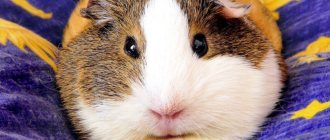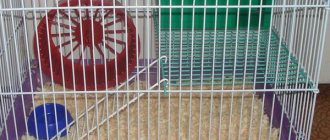Today, perhaps every child dreams of having their own pet. After all, gadgets are gadgets, and no one has canceled the need to communicate with wildlife, especially if you live in an urban environment. Pets not only bring a special atmosphere and color to the house, but also help younger family members learn responsibility and sensitivity, mutual assistance and kindness, not from abstract book examples, but as a result of their own experience of interacting with one or another animal. However, in many cases, for example, due to small living space, it is impossible to have a cat or dog in an apartment. In order not to deprive your child of the pleasure of communicating with a pet, it is worth thinking about smaller pets: fortunately, there are many such animals, no less cute than cats and dogs. The main thing is not to try to follow fashion, but to choose an animal to your liking. We present a small top list of pets for children, with whom living together can become happy and comfortable even in a small apartment.
pixabay.com/
Benefits of keeping animals in a home with young children
Many parents, thinking about what kind of pet to get their child and whether it is worth doing it, have repeatedly replayed in their imagination the most unpleasant “side effects” that are characteristic of living side by side with an animal. Of course, when you get a pet, you may encounter such unpleasant phenomena as a specific smell, damaged wallpaper and furniture, wool on carpets and things. However, the benefits of having a pet in the house are still much greater. After all, he can not only become an excellent friend for a child, but also helps his mental, social and mental development, increases physical activity, fosters independence, kindness, sensitivity and other important human qualities, opens up new opportunities for communication, relieves feelings of loneliness and, Of course, it helps to build harmonious relationships between all family members.
What pets are most often owned?
There is a whole group of animals that children ask to buy the most:
- Cats
. This animal is the least whimsical. It does not require special care and takes up very little space. But interest drops as soon as the kitten grows up and begins to be lazy in chasing the bow. - Dogs
. These animals take an honorable second place. Indeed, a dog is a child’s friend. You can train her and play with her. Many parents buy this pet to protect their home and child. - Various rodents
(rats, rabbits, hamsters and other living creatures) are very unpretentious, undemanding and economical. Even a small child can be entrusted with the care of such pets. - Fish in an aquarium
can bring a lot of pleasure to children and relaxation to parents. They will not cause allergies and do not require constant communication and training. All that is necessary is to feed and clean the aquarium on time. - Birds.
The advantage is financial undemandingness. The disadvantage is that it is noisy and requires constant maintenance. For a child, birds are more interesting friends, because you can always establish verbal contact and even communicate with them.
How to choose a pet based on the age and character of the child
A pet is not a toy and it will last a long time. That is why the choice of an animal should not be dictated only by its external attractiveness or the advice of friends. It is important to understand whether a living gift is suitable specifically for your child. For example, if a child is still too small, he may, without fully realizing the responsibility, severely frighten or accidentally injure the pet, or even injure himself. This is why most experts do not recommend having pets for children under six years of age. And, of course, you are unlikely to get conscious, regular assistance in caring for your pet from an undergrown offspring.
In addition, the animal and the child must “get along in character.” Only in this case, true friendship, love and mutual understanding are possible between them. For example, if your child is phlegmatic, a parrot, canary or any other bird is unlikely to suit him: a pet that is too noisy, active and “talkative” can irritate him. Most likely, such a child will prefer hamsters or guinea pigs, and if he is also easily vulnerable, then you can opt for an aquarium with fish.
And, of course, when deciding which animal to give to your child, you need to visit a pediatrician in order to exclude the possibility of allergic reactions even before the animal appears in the house. And only after that you should choose an animal from the abundance of offers.
What to look for when choosing a pet
All factors must be taken into account:
- Housing size . In a small apartment, for example, you won’t be able to have a large dog. Cats also need space, especially if they don't roam outside.
- All the pros and cons of the selected animal . Are you ready to put up with the noise and flying feathers of birds, fur of cats and dogs? Is frequent cleaning intimidating, or is it better to choose someone less demanding? Do you like sociable and intelligent animals, or is contemplation of silent fish more attractive?
- Allergy of one of the family members . Allergies to animal fur are common. Then you will have to choose, for example, fish, a turtle.
- Financial opportunities . Animal food, cages, aquariums, terrariums, accessories and toys, veterinary services if necessary - all this costs money. Some animals are definitely cheaper to buy than others.
Remember that the choice always remains with the adult. Even if a child begs to take an animal and vows to take care of it, you need to understand that he is simply not yet able to understand all the responsibility and possible problems.
Option one: the ass is not a fool
Parrots are one of the most popular pets, and for good reason. After all, these birds are unusually playful and friendly and love to interact with people. And, of course, parrots of all stripes are endowed with a very attractive appearance, which is difficult for even seasoned adults to “resist”: these are gray with mother-of-pearl, and bright lemon, and lilac, and blue, and birds painted with all the colors of the rainbow.
A distinctive feature of parrots, as already noted, is their high activity. The noisy behavior of these cheerful individuals, capable of emitting piercing screams for several minutes in order to attract attention, can sometimes make your head spin. In addition, many of these communicative creatures are capable of copying various sounds, and this applies not only to human speech, but also, for example, to a police siren. Therefore, it is a common thing for a parrot owner to rush to the supposedly ringing phone: the bird just decided to have a little fun, exactly imitating the call signal. Not to mention the fact that parrots often make adults blush seriously, realizing that the child has borrowed a couple of not very decent words and expressions from his pet.
Nevskie News / Stepan Yatsko
Another important feature of parrots is that, despite the sociability of these individuals, communication with them is still built at a certain distance. Of course, no one forbids you to pet your favorite bird, but it is unlikely that such treatment will be pleasant for her. In the worst case, you can get bitten by the beak for too actively imposed caresses. Parrots especially do not like it when strangers touch them.
A parrot needs a clean cage, as well as special food, drinking water and toys. The cage should be large enough so that the bird can fully spread its wings in it and fly from perch to perch. You can occasionally offer your pet salted crackers and nuts as a treat. However, even frequent treats will not save you from the need to frequently clean the area adjacent to the cage, because parrots are characterized by a desire to constantly scatter food. With good care and health, many parrots can live to be 80 years or more.
Hamsters
They can compete with dogs and cats for the title of the most popular children's pet. Hamsters are easy to care for, but require many additional “attributes”. They need a house or cage, a feeder, a water bowl, a wheel for physical activity, building materials for a nest and, very preferably, a partner to start a family.
Note! Hamsters are nocturnal, which means that they will also run in their wheel at night. Not all owners like this, including the smallest ones. After all, these little ones can make a lot of noise!
Option two: overseas, land
It is only in Russia and Germany that guinea pigs are called “guinea pigs.” In fact, they were originally called “overseas”, since this rodent did not come to us from the depths of the sea, but was brought from overseas. In our country, guinea pigs are among the top most popular pets, so when wondering what kind of animal to have in an apartment for a child, many parents choose them. The disposition of these animals is extremely peaceful and sociable, and at the same time pigs are among the largest rodents: mature individuals can grow up to 30 centimeters in length, so they can easily “pass” for a small lap dog. Guinea pigs live from 5 to 10 years and do not have any special health problems, unless, of course, they are overfed and monitor their diet, which must include special food in granules, fresh hay, fruits and vegetables.
Compared to smaller rodents, pigs are less temperamental and not at all prone to aggression, so the danger of being bitten is extremely low. These animals love to interact with both their owners and other guinea pigs. It is with these animals that it is convenient to begin teaching a child to take responsible care of a pet.
pixabay.com/
You can easily purchase a comfortable cage for a guinea pig at any pet store. It is also customary to add various accessories to it so that the animal does not get bored. You just shouldn’t offer them a “wheel”, because a pig is a fairly large rodent, so such entertainment is fraught with injuries to its back and legs.
Hamsters, guinea pigs and rats
These little pets adapt well to apartment life. Hamsters, guinea pigs and rats only need a small cage, food and minimal interaction with people. They are relatively undemanding animals. What is unique about these pets is their nocturnal lifestyle. As soon as you go to bed, you can hear their stomping, grinding, squeaking. But this warning is only for those who sleep lightly.
Guinea pigs and rats need to live in pairs or groups. Because they need to play and communicate.
Option three: let's hamster with you
Let's talk about other rodents that are popular and comfortable to keep at home. These are hamsters and gerbils. Both of them are distinguished by their cutest appearance, are endowed with quite fluffy fur and willingly allow themselves to be picked up, although sometimes they behave extremely restlessly “in public”. True, in the case of a gerbil, this should be done with extreme caution, since the animals are fragile and can easily be accidentally injured.
There are many different types of hamsters. Visually, they differ from each other, primarily in size. For particularly active children who need to babysit their pets for a long time, larger species are suitable - for example, the Syrian hamster. They are not so fragile, and are also much more amenable to education. As for gerbils, despite their species diversity, the Mongolian gerbil is most often found in apartments.
Hamsters are somewhat of an individualist. That is why it is better to complement the cage with various accessories - tunnels, wheels, transitions, etc. - to help hamsters maintain normal vitality and health. They also do not need partners of the opposite sex too much. Unlike hamsters, gerbils are social animals that form colonies in their natural habitat. Therefore, experts recommend keeping them in small groups of two to four individuals. But don’t worry: just like hamsters, they are extremely unpretentious and economical to keep. The tendency of both rodents to create food reserves at the first opportunity is further confirmation of this. It is no coincidence that the cute verb “hamster” has taken root among the people, applied not only to an intensively chewing person, but also to an extremely thrifty person.
pixabay.com/_Alicja_
Hamsters, unlike gerbils, are characterized by a nocturnal lifestyle; during daylight hours, these animals are of little interest: they hibernate almost the entire day. Representatives of both types of rodents do not live very long: hamsters - from 2.5 to three years, and gerbils - from three to four. So, you will have to mentally prepare your child for the fact that after some time he will part with his beloved pet forever.
Budgie
As with the canary, the only thing a parrot needs is a well-stocked cage. This means that it must contain mandatory interior items - a drinking bowl, a feeder and a bathtub. Important characteristics of the cell:
- rectangular shape;
- spacious;
- the presence of perches, swings, ladders;
- the presence of sand at the bottom of the cage.
It is best to place the parrot's house in a bright place. It is important to avoid drafts and direct sunlight.
You can feed the bird with specialized food or supplements, which are sold at any pet store. There are additional requirements for water, since tap or boiled water is not suitable for birds. Therefore, the best option would be drinking still water.
A few more recommendations for caring for a parrot that will not burden the owner too much:
- during the molting period, it is recommended to add 2-3 drops of freshly squeezed lemon juice to the drinker;
- To prevent the bird from growing the tip of its beak, which interferes with eating, the bird should sometimes be offered fresh branches (linden or rowan) or special mineral stones.
Option four: clerical master
Office rat is a definition that is quite offensive both for the person and for the rat itself, which served as the “prototype” for this expression. Indeed, so what if, while entertaining itself, this cute, active and sociable animal loves to rustle with paper, strings and other toys and improvised objects? It is extremely unfair to associate him with careless clerks just because of this innocent habit. Moreover, the rat is an exceptionally smart animal, which also has an excellent memory. This is one of the cleanest and most unpretentious pets; care for it is also minimal and will not put too much strain on your budget. And, which is absolutely incredible for many, the rat becomes very attached to its owner, so, most likely, harmony will easily reign between it and your child. In short, a rat is an almost ideal “small-sized” pet. The only “but”: these rodents, like hamsters and gerbils, do not live long - only two to three years.
Press service of the pet exhibition “Zooshow” /
Crayfish, hermits and shrimp
A large tank with sand, shells, toys, food and a bowl of water is everything you need to keep your hermit crab happy. Despite its name, it is a very social animal that loves to move - especially in the evening. These little creatures love to hide in piles of sand and can live up to three decades!
Shrimp is a new trend in the pet world. They live in a clean, closed terrarium, with algae and mosses. Beginners can also keep shrimp, but these pets are very sensitive to the chemical composition of the water and the environment in general. Water should always be clean and settled. The use of various sprays and aerosols is undesirable in the room where there is an aquarium with shrimp.
Option five: a professional hide and seek game
As a gift for an active child, you can consider purchasing a ferret, which will most likely suit his temperament perfectly. These are extremely active, curious and agile animals, with a pretty appearance and a pleasant fluffy coat.
As soon as you let the animal out of the cage, it starts running around the entire apartment, looking into literally every corner, which is why you should not leave it unattended for a long time. Otherwise, the animal will certainly want to play hide and seek with you, and finding it will be very difficult. You shouldn’t go to the other extreme, locking your pet in a cage for a long time, because ferrets, to a much greater extent than, for example, rats, need attention and good company. It is no coincidence that many owners, leaving the apartment for personal business, now and then take them with them, like pocket dogs. The ferret will gladly go into your arms and will not even think about biting - of course, provided that you do not harm him. And this animal can play with its little owner for days on end.
Ferrets live much longer than other small pets - approximately eight to ten years.
pixabay.com/
Canary
The house canary is a domesticated subspecies of the Canarian (hence the name) canary finch, native to the Canary Islands, the Azores and Madeira Islands. Thanks to its singing, this bird gained enormous fame and became in demand as a pet.
The canary does not require special care. It is enough to purchase a cage with a tray, drinking bowl and perches.
The bottom of the cage is most often used as a toilet, so it is recommended to cover it with a small layer of sand and regularly update the composition. The procedure will help get rid of the smell of feces, and the more often it is repeated, the better. In addition, sand tends to crumble over time, which also requires regular replenishment. Obviously, a busy person does not have time for this. In this case, instead of sand, you can use regular paper, which is enough to change once every 2-3 days.
The canary should be fed every day. If the schedule does not allow, then you can limit yourself to replenishing the feeder once every 2-3 days. The volume must be selected in accordance with the frequency of feeding - the less often it is, the greater the amount of feed required.
Despite being busy, the canary must be let out of the cage at least once a week. A room that is not filled with furniture and various equipment is best suited for this. To enjoy freedom, the bird only needs to fly for 2-3 hours.
Canaries love water treatments. And this is not surprising, because bathing cleanses the skin and strengthens the plumage. The water should be at room temperature.
Some people mistakenly assume that canaries are restless creatures that give no rest to their owners and mercilessly wake them up at the crack of dawn. This problem can be solved very simply - with the help of a dark dense cloth, which is used to cover the cage at night.
The bird trusts people, so there are usually no difficulties with its behavior at home.
Option six: fluffy but independent
In terms of fluffiness, the real champions on our list are chinchillas. These miniature animals, with thick and silky fur, are very pleasant to pet. Moreover, this animal is extremely clean and has almost no unpleasant odor. However, the chinchilla does not really like being compulsively squeezed: with much greater pleasure she runs around the apartment.
The chinchilla is unpretentious in keeping, and even the special food that is required to feed it can be easily found in almost any pet store. If you purchased a female chinchilla, then it is unlikely that she will feel the need for the company of her own kind, but it is recommended to have males in pairs.
Adult chinchillas grow up to 30 centimeters or more in length, and females are much larger than males. The lifespan of fluffies is from 10 to 15 years.
pixabay.com/Adam Białasik
Bird for a child
When buying a bird, you need to determine whether it will be able to spend a lot of time outside the cage in the house and interact with adults, a child, or, conversely, will spend most of the time in a cage. Since all types of birds exhibit different patterns of behavior. The behavior of an African parrot will be significantly different from that of a canary. It is necessary to find out the behavioral characteristics of different types of birds and choose the one that suits the temperament.
Large birds have more responsibilities for maintenance and care. They are noisier and messier than small breeds. Some birds can scream all day long.
Feeding: pressed mixtures of natural fruits, berries, corn, sunflower seeds, pine nuts. This food is enriched with vitamins. They also need to be given dried fruits, meat, offal, cereals, dairy products, sorbitol, glycerin, oils, minerals, algae, sugar.
Among other things, the lifespan of birds must also be taken into account. For example, a budgerigar lives about 30 years, and a macaw lives from 50 to 100 years.
Poultry ownership can be prohibitively expensive. Large individuals cost up to several thousand dollars, cages and all accessories are also not cheap. To begin with, it is better to buy an ordinary budgie, the price of which starts from 500 rubles.
Option seven: not only valuable fur...
...but also a great companion for your child. We are, of course, talking about rabbits - cute, active, affectionate, playful and sociable creatures, which, moreover, are quite trainable. A rabbit is an ideal gift for an already grown-up child, because if you do not treat the pet roughly and do not frighten it unnecessarily, then it will demonstrate a calm, kind disposition, become truly attached to your child and become a good and reliable friend for him. Especially considering that on average rabbits live 5-10 years.
To stay healthy, your rabbit must be able to move actively. And since by nature this animal is endowed with a problematic digestive system, it will need special food, which from time to time is recommended to be “diluted” with fresh vegetables and fruits. Some particularly furry animals may require regular brushing. Otherwise, these popular pet rodents are quite unpretentious.
pixabay.com/Anastasia Gepp
Cat for a child
This is the most popular pet. You can get a purebred kitten from an advertisement for free, but purebred kittens with a pedigree are not cheap to buy. The choice is great.
Cats scratch, hiss, are capricious, selfish, and some simply don’t always want to play with their owner. Therefore, they may not be suitable for a small child. You need to choose the cat's character. Thoroughbreds often get sick and often do not have a very good character.
Of course, while the baby is small, parents will have to clean the pet’s toilet. And when the child grows up, you will have to constantly remind him about cleaning or continue to clean yourself.
There is another issue with cats - this is sterilization or castration, which costs money.
The most popular breeds: Savannah (the most expensive), Chausie, Safari, Bengal, American Curl, Toyger, Elf, Serengeti, Russian Blue, Laperm, Maine Coon, British Shorthair, Canadian Sphynx, Scottish Fold (or Scottish Fold), Himalayan , Peterbald (or St. Petersburg Sphynx), Devon Rex.
The best cat breeds for children: Abyssinian, American Shorthair, Burmese, Burmese, Maine Coon, Manx, Persian, Ragdoll.
Option eight: prickly positive
Many of us have encountered hedgehogs living in the wild. These animals often wander into city parks and like to stay in summer cottages. It is not surprising that even after a short interaction with a hedgehog, many children ask their parents to get them such an exotic pet. However, wild hedgehogs are not very suitable for keeping at home. After all, they, first of all, are carriers of many infections. And their life expectancy when separated from their natural habitat is, as a rule, no more than a year.
That is why it is recommended to contact breeders to purchase a hedgehog: specially bred “breeds” do not pose a danger to humans, and at the same time they can live up to ten years or more. In addition, the specialist will tell you in detail about the intricacies of feeding and keeping your prickly companion. In general, hedgehogs are great for older children. They are unpretentious and independent and, with sufficient attention from the owner, can quickly turn into an obedient and sociable pet.
Global Look Press/Quim Muns
Of course, the list presented is far from complete, and you could easily continue it with turtles, raccoons, snails or even skunks. The main thing is not to get too carried away when going through the options, and to remember that the best pet for a child is not some fantastically handsome, smart and rarity, but the one that he himself will consider the best and loved.
Aquarium fish for children
A beautiful underwater world that calms the nervous system. You can sit in front of the aquarium for a long time, watching and relaxing, as well as discussing the life of marine life. Even the snails, which are constantly busy cleaning themselves, are very interesting.
The child will only be able to feed the fish and help a little in cleaning the aquarium. Of course, washing it completely will fall on the shoulders of the parents. Although a child of older preschool or school age can help more.
You can add a frog, crayfish or shrimp to the aquarium. The most unpretentious frog is the clawed frog (from 2 cm), but it can only be used with large fish. Dwarf orange crayfish (1.5 cm) will also revive the aquarium, without harming small inhabitants and plants. The most popular shrimp is the red cherry shrimp, which makes a nice addition to the underwater world.
Prices for aquariums depend on size and configuration.











